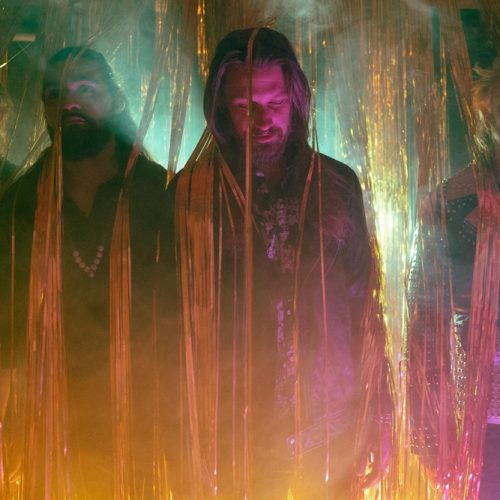There are so many flavors of indie rock that it’s hard to say you “miss” any one kind of it, because there’s almost certainly a dozen Bandcamp pages that can scratch any itch you have. But as the dominant strains of indie rock have grown more dreamy (your Beach Houses, your Real Estates) and/or more lyrics-focused (your Phoebe Bridgerses and Mitskis), some good old-fashioned guitar squalls are more than welcome. It’s nice to have something that makes you want to turn the volume up and lose yourself in churning chords and feedback.
Joshua Powell, the Indianapolis-based singer-songwriter and guitarist behind “Sad Boy at the Skeleton Party,” is more than willing to provide. His sound, along with collaborator Adam Shuntich’s, is definitely a throwback, a mix of crunchy power-pop chords and wheedly, lightly psychedelic solos, but that doesn’t mean it’s not satisfying as hell. It helps that Powell is so adept with hooks of all kinds: you’re bound to have the chorus, and likely a couple of the verses, bouncing around in your head for a while afterwards. The lyrics were inspired by the design of one of Powell’s t-shirts, and there’s a playful spirit as the titular party is described (one of them is “keeping up on his union dues and crushing beers.”) All in all, it’s great fun, and the fact that it’s clearly made with care makes it even more fun.
The title of this song is certainly a striking image, and the lyrics back it up. What was the impetus behind this song?
I love the idea of retroactive continuity because it’s a spiritual way of giving yourself agency in your experience of the world and to unbind yourself from the sticky paws of TIME, baby. In other interviews after I’ve talked about this song a lot, I’ll recognize some themes and get a little cleverer sounding about it, and a year from now I’ll be convinced that was my grand design from the jump. But it doesn’t happen like that. You’re at the mercy of the making while it’s happening, and then you assert control over the experience afterward by how you tell the story.
Years ago, I asked one of my favorite artists, Daniel Jeffrey, to make us a death metal shirt. He drew a monk-looking dude bent over a scroll with these little oni demons tormenting him. It was badass and sold well and I loved it. I had it called something pretentious in our store like “The Scholar and His Demons,” when our producer friend Jon Class saw it and said, “Ha! A sad boy at the skeleton party!” Three years later I was still thinking about that line, so I started writing a song about it. It’s crazy that it stuck as an album title.
I was stoked when Daniel was down to work with us again and he reimagined the image for the cover. Then we also riffed on that imagery for the music video, which our friend Matt Panfil directed. But it started with Daniel’s drawing. The whole record is essentially ret-con.
What does your lyric-writing process look like? Is it organized or more stream-of-consciousness?
It’s warped over time. I dig the cadential challenge of setting story to music, which is why I came up such a folky boy and a lot of my earlier work had very cohesive ballads. After immersing myself in fiction for most of my life though, I started to get really turned on by story structures that subverted expectations and pushed formal boundaries, which is why I’m on about David Lynch all the damn time.
The hero’s journey is exhausted. What I’ve learned from Lynch, from Alejandro Jodorowsky and Ryu Murakami, is that your story can be absolutely intoxicating and richer than Scrooge McDuck without making a lick of sense. I worried beforehand how I’d talk about “Sad Boy” and what I would say it meant when people asked, because it starts off being about how the moon is a pretty cool guy, and then we bond over my ability to restore his broken skate deck with magic, and that’s all before the first chorus. It was very freeing to start in one direction and then to let the song go where it wanted instead of shoehorning in a perfect arc for every character. In that way, to me, it feels both more dreamlike and more true to life.
The guitar work is especially impressive here. Tell us something about the guitar-playing here that a casual listener may not have picked up on.
Thanks! Big credit to Adam Shuntich on that one, he was a banshee on the solos he wrote for this. At the height of the plague, he was in the Zoom dojo with his old sensei Kevin Glazand and with Sturgill Simpson’s former guitarist, Laur Joamets, workshopping that stuff. I used to use primitivism and punk as false flags against the concept of actually getting great at my instrument, but you grow up, you know? Hanging out with Adam all the time, meant seeing someone already good getting great up close, what that practice looks like. We both woodshedded it for a few years teaching at a music school where I got the chance to chop up and break down a lot of dumb preconceptions I had about what rock music was cool, so that got me very interested in playing more technically. And you know what’s cooler than a guitar solo? Two guitar solos. Or at least that’s a functioning thesis of this record.
What are your ambitions for the future?
I would like to woo the staff of NPR Music into sling-shotting us into our critical darlinghood. I would like very much to go on tour with King Gizzard and the Lizard Wizard. Of course I aspire to be able to levitate, even just a little bit. I wanna keep this incarnation of the band together, I love ‘em and I think we’ve got legs. I am not ambitious on the same channels that I used to be. I’m practicing being here now and it’s fuckin’ wild.







